Green Synthesis of ZnO Nanoparticles Using Licania tomentosa Benth (Oiti) Leaf Extract: Characterization and Applications for the Photocatalytic Degradation of Crystal Violet Dye
Abstract
1. Introduction
2. Material and Methods
2.1. Materials
2.2. Preparation of the Plant Extract
2.3. ZnO NPs Synthesis
2.4. Physical Characterization of the Obtained Green NPs
2.5. Photocatalytic Activity
3. Results and Discussion
3.1. Structural Analysis and Average Crystallite Size
3.2. SEM Analysis
3.3. UV-Vis Spectroscopy
3.4. FT-IR Spectroscopy Analysis
3.5. Photocatalysts Activity
3.6. Mechanism of CV Dye Degradation
3.7. Optimization Studies
3.7.1. Optimization of ZnO Catalyst Loading
3.7.2. Effect of Temperature
3.7.3. Impact of UV Light Intensity
3.7.4. Effect of pH
4. Conclusions
Author Contributions
Funding
Data Availability Statement
Acknowledgments
Conflicts of Interest
References
- Zolkefli, N.; Sharuddin, S.S.; Yusoff, M.Z.M.; Hassan, M.A.; Maeda, T.; Ramli, N. A review of current and emerging approaches for water pollution monitoring. Water 2020, 12, 3417. [Google Scholar] [CrossRef]
- Arman, N.Z.; Salmiati, S.; Aris, A.; Salim, M.R.; Nazifa, T.H.; Muhamad, M.S.; Marpongahtun, M. A review on emerging pollutants in the water environment: Existences, health effects and treatment processes. Water 2021, 13, 3258. [Google Scholar] [CrossRef]
- Ferreira, V.; Magalhães, R.; Teixeira, P.; Castro, P.M.L.; Calheiros, C.S.C. Occurrence of fecal bacteria and zoonotic pathogens in different water bodies: Supporting water quality management. Water 2022, 14, 780. [Google Scholar] [CrossRef]
- Castro-Jiménez, C.C.; Saldarriaga-Molina, J.C.; García, E.F.; Correa-Ochoa, M.A. Primary treatment of domestic wastewater with the use of unmodified and chemically modified drinking water treatment sludge. Sustainability 2022, 14, 9827. [Google Scholar] [CrossRef]
- Constantin, C.; Popescu, I.C.; Oprea, O.; Stoica, L. U (VI) removal from diluted aqueous systems by sorption–flotation. Sci. Rep. 2022, 12, 16951. [Google Scholar] [CrossRef] [PubMed]
- Nechifor, A.C.; Cotorcea, S.; Bungău, C.; Albu, P.C.; Pașcu, D.; Oprea, O.; Grosu, A.R.; Pîrțac, A.; Nechifor, G. Removing of the sulfur compounds by impregnated polypropylene fibers with silver nanoparticles-cellulose derivatives for air odor correction. Membranes 2021, 11, 256. [Google Scholar] [CrossRef]
- Petrișor, G.; Motelica, L.; Ficai, D.; Ilie, C.-I.; Trușcǎ, R.D.; Surdu, V.-A.; Oprea, O.-C.; Mȋrț, A.-L.; Vasilievici, G.; Semenescu, A.; et al. Increasing bioavailability of trans-ferulic acid by encapsulation in functionalized mesoporous silica. Pharmaceutics 2023, 15, 660. [Google Scholar] [CrossRef]
- Adefisoye, M.A.; Olaniran, A.O. Does chlorination promote antimicrobial resistance in waterborne pathogens? Mechanistic insight into co-resistance and its implication for public health. Antibiotics 2022, 11, 564. [Google Scholar] [CrossRef]
- Spoială, A.; Ilie, C.-I.; Dolete, G.; Croitoru, A.-M.; Surdu, V.-A.; Trușcă, R.-D.; Motelica, L.; Oprea, O.-C.; Ficai, D.; Ficai, A.; et al. Preparation and characterization of chitosan/TiO2 composite membranes as adsorbent materials for water purification. Membranes 2022, 12, 804. [Google Scholar] [CrossRef]
- Sudiarti, T.; Ulpah, F.; Sanusi; Listiani, P.; Ichikawa, Y.; Honda, M.; Amelia, S.R.; ’Adany, F.; Nurrosyid, N.; Ivansyah, A.L. Unlocking the photocatalytic and antibacterial properties of triple and quadruple doped ZnO nanoparticles (Mg/Cu/N-ZnO and Mg/Cu/N/B-ZnO) prepared by one pot facile solid state synthesis. Adv. Powder Technol. 2024, 35, 104567. [Google Scholar] [CrossRef]
- Khan, A.K.; Renouard, S.; Drouet, S.; Blondeau, J.-P.; Anjum, I.; Hano, C.; Abbasi, B.H.; Anjum, S. Effect of UV irradiation (A and C) on Casuarina equisetifolia-mediated biosynthesis and characterization of antimicrobial and anticancer activity of biocompatible zinc oxide nanoparticles. Pharmaceutics 2021, 13, 1977. [Google Scholar] [CrossRef] [PubMed]
- Joseph, J.A.; Nair, S.B.; John, S.S.; Remillard, S.K.; Shaji, S.; Philip, R.R. Zinc-doped iron oxide nanostructures for enhanced photocatalytic and antimicrobial applications. J. Appl. Electrochem. 2021, 51, 521–538. [Google Scholar] [CrossRef]
- Ikhmayies, S.J. Synthesis of ZnO microrods by the spray pyrolysis technique. J. Electron. Mater. 2016, 45, 3964–3996. [Google Scholar] [CrossRef]
- Singh, J.; Dutta, T.; Kim, K.H.; Rawat, M.; Samddar, P.; Kumar, P. ‘Green’ synthesis of metals and their oxide nanoparticles: Applications for environmental remediation. J. Nanobiotechnology 2018, 16, 84. [Google Scholar] [CrossRef]
- Bala, N.; Saha, S.; Chakraborty, M.; Maiti, M.; Das, S.; Basu, R.; Nandy, P. Green synthesis of zinc oxide nanoparticles using Hibiscus subdariffa leaf extract: Effect of temperature on synthesis, anti-bacterial activity and anti-diabetic activity. RSC Adv. 2015, 5, 4993–5003. [Google Scholar] [CrossRef]
- Sharma, S.; Kumar, K.; Thakur, N.; Chauhan, S.; Chauhan, M.S. The effect of shape and size of ZnO nanoparticles on their antimicrobial and photocatalytic activities: A green approach. Bull. Mater. Sci. 2020, 43, 20. [Google Scholar] [CrossRef]
- Arumugam, J.; Thambidurai, S.; Suresh, S.; Selvapandiyan, M.; Kandasamy, M.; Pugazhenthiran, N.; Kumar, S.K.; Muneeswaran, T.; Quero, F. Green synthesis of zinc oxide nanoparticles using Ficus carica leaf extract and their bactericidal and photocatalytic performance evaluation. Chem. Phys. Lett. 2021, 783, 139040. [Google Scholar] [CrossRef]
- Sadiq, H.; Sher, F.; Sehar, S.; Lima, E.C.; Zhang, S.; Iqbal, H.M.; Zafar, F.; Nuhanović, M. Green synthesis of ZnO nanoparticles from Syzygium cumini leaves extract with robust photocatalysis applications. J. Mol. Liq. 2021, 335, 116567. [Google Scholar] [CrossRef]
- Mirza, S.; Hussaini, A.A.; Öztürk, G.; Turgut, M.; Öztürk, T.; Tugay, O.; Ulukuş, D.; Yıldırım, M. Photocatalytic and antibacterial activities of ZnO nanoparticles synthesized from Lupinus albus and Lupinus pilosus plant extracts via green synthesis approach. Inorg. Chem. Commun. 2023, 155, 111124. [Google Scholar] [CrossRef]
- Elavarasan, N.; Kokila, K.; Inbasekar, G.; Sujatha, V. Evaluation of photocatalytic activity, antibacterial and cytotoxic effects of green synthesized ZnO nanoparticles by Sechium edule leaf extract. Res. Chem. Intermed. 2017, 43, 3361–3376. [Google Scholar] [CrossRef]
- Andrade, E.H.A.; Zoghbi, M.G.B.; Maia, J.G.S. Constituintes volateis dos frutos de Licania tomentosa. Acta Amaz. 1998, 28, 55–58. [Google Scholar] [CrossRef]
- Carnevale Neto, F.; Pilon, A.C.; da Silva Bolzani, V.; Castro-Gamboa, I. Chrysobalanaceae: Secondary metabolites, ethnopharmacology and pharmacological potential. Phytochem. Rev. 2013, 12, 121–146. [Google Scholar] [CrossRef]
- Zamproni, K.; Biondi, D.; Maria, T.R.B.C.; Louveira, F.A. Diagnóstico quali-quantitativo da arborização viária de Bonito, Mato Grosso do Sul. Floresta 2018, 48, 235–244. [Google Scholar] [CrossRef]
- Monteiro, K.L.; de Oliveira, C.; da Silva, B.M.; Moro, F.V.; de Carvalho, D.A. Morphological characteristics of fruit, seed e post-seminal development of Licania tomentosa (Benth.) Fritsch/Caracterizacao morfologica de frutos, de sementes e do desenvolvimento pos-seminal de Licania tomentosa (Benth.) Fritsch. Cienc. Rural 2012, 42, 90–98. [Google Scholar] [CrossRef]
- Castilho, R.O.; Kaplan, M.A.C. Chemical constituents of Licania tomentosa Benth. (Chrysobalanaceae). New Chem. 2008, 31, 66–69. [Google Scholar]
- Macêdo, J.B.M. Capacidade Antioxidante In Vitro e Avaliação da Toxicidade Aguda In Vivo de Extratos de Folhas de Licania rígida Benth., Licania tomentosa (Benth.) Fritsch e Couepia Impressa Prance (Chrysobalanaceae). Master’s Thesis, Universidade Federal do Rio Grande do Norte, Natal, Brazil, 2011. [Google Scholar]
- Farias, D.F.; Souza, T.M.; Viana, M.P.; Soares, B.M.; Cunha, A.P.; Vasconcelos, I.M.; Ricardo, N.M.P.S.; Ferreira, P.M.P.; Melo, V.M.M.; Carvalho, A.F.U. Antibacterial, antioxidant, and anticholinesterase activities of plant seed extracts from Brazilian semiarid region. BioMed Res. Int. 2013, 2013, 510736. [Google Scholar] [CrossRef]
- Agra, M.D.F.; De Freitas, P.F.; Barbosa-filho, J.M. Divulgação Synopsis of the plants known as medicinal and poisonous in Northeast of Brazil. Rev. Bras. Farmacogn. 2007, 17, 114–140. [Google Scholar] [CrossRef]
- Prakoso, S.P.; Saleh, R. Synthesis and spectroscopic characterization of undoped nanocrytalline ZnO particles prepared by co-precipitation. Mater. Sci. Appl. 2012, 3, 530–537. [Google Scholar] [CrossRef]
- Alharthi, F.A.; Alghamdi, A.A.; Alothman, A.A.; Almarhoon, Z.M.; Alsulaiman, M.F.; Al-Zaqri, N. Green synthesis of ZnO nanostructures using Salvadora Persica leaf extract: Applications for photocatalytic degradation of methylene blue dye. Crystals 2020, 10, 441. [Google Scholar] [CrossRef]
- Aldeen, T.S.; Mohamed, H.E.A.; Maaza, M. ZnO nanoparticles prepared via a green synthesis approach: Physical properties, photocatalytic and antibacterial activity. J. Phys. Chem. Solids 2022, 160, 110313. [Google Scholar] [CrossRef]
- Mayekar, J.; Dhar, V.; Radha, S. Role of salt precursor in the synthesis of zinc oxide nanoparticles. Int. J. Res. Eng. Technol. 2014, 3, 43–45. [Google Scholar]
- Theivarasu, C.; Indumathi, T. Effect of rare earth metal ion Ce3+ on the structural, optical and magnetic properties of ZnO nanoparticles synthesized by the co-precipitation method. J. Mater. Sci. Mater. Electron. 2017, 28, 3664–3671. [Google Scholar] [CrossRef]
- Borysiewicz, M.A. ZnO as a functional material, a review. Crystals 2019, 9, 505. [Google Scholar] [CrossRef]
- Koch, U.; Fojtik, A.; Weller, H.; Henglein, A. Photochemistry of semiconductor colloids. Preparation of extremely small ZnO particles, fluorescence phenomena and size quantization effects. Chem. Phys. Lett. 1985, 122, 507–510. [Google Scholar] [CrossRef]
- Khan, M.M.; Saadah, N.H.; Khan, M.E.; Harunsani, M.H.; Tan, A.L.; Cho, M.H. Potentials of Costus woodsonii leaf extract in producing narrow band gap ZnO nanoparticles. Mater. Sci. Semicond. Process. 2019, 91, 194–200. [Google Scholar] [CrossRef]
- Pantidos, N.; Horsfall, L.E. Biological synthesis of metallic nanoparticles by bacteria, fungi and plants. J. Nanomed. Nanotechnol. 2014, 5, 1. [Google Scholar] [CrossRef]
- Ayyanusamy, P.; Alphonse, R.; Minakshi, M.; Sivasubramanian, R. Synthesis of Amorphous Nickel-Cobalt Hydroxides for Ni−Zn Batteries. Chem. Eur. J. 2024, 30, e202402325. [Google Scholar] [CrossRef]
- Minakshi, M.; Samayamanthry, A.; Whale, J.; Aughterson, R.; Shinde, P.A.; Ariga, K.; Kumar Shrestha, L. Phosphorous-containing activated carbon derived from natural honeydew peel powers aqueous supercapacitors. Chem. Asian J. 2024, 19, e202400622. [Google Scholar] [CrossRef]
- Ragunathan, R.; Velusamy, S.; Nallasamy, J.L.; Shanmugamoorthy, M.; Johney, J.; Veerasamy, S.; Gopalakrishnan, D.; Nithyanandham, M.; Balamoorthy, D.; Velusamy, P. Synthesis and Enhanced Photocatalytic Activity of Zinc Oxide-Based Nanoparticles and Its Antibacterial Activity. J. Nanomater. 2022, 2022, 3863184. [Google Scholar] [CrossRef]
- Álvarez-Chimal, R.; García-Pérez, V.I.; Álvarez-Pérez, M.A.; Arenas-Alatorre, J.Á. Green synthesis of ZnO nanoparticles using a Dysphania ambrosioides extract. Structural characterization and antibacterial properties. Mater. Sci. Eng. C 2021, 118, 111540. [Google Scholar] [CrossRef]
- Ameen, S.; Akhtar, M.S.; Nazim, M.; Shin, H.S. Rapid photocatalytic degradation of crystal violet dye over ZnO flower nanomaterials. Mater. Lett. 2013, 96, 228–232. [Google Scholar] [CrossRef]
- Puneetha, J.; Kottam, N.; Rathna, A. Investigation of photocatalytic degradation of crystal violet and its correlation with bandgap in ZnO and ZnO/GO nanohybrid. Inorg. Chem. Commun. 2021, 125, 108460. [Google Scholar]
- Yelpale, A.M.; Patil, V.L.; Bhosale, S.R.; Bhosale, R.R.; Dhavale, R.P.; Vhangutte, P.P.; Kamble, A.J.; Bhange, D.S.; Mane, S.M.; Lee, J.; et al. Efficient photocatalytic degradation of crystal violet dye using time-dependent ZnO nano spindle. Mater. Sci. Eng. B 2024, 310, 117687. [Google Scholar] [CrossRef]
- Ameur, S.B.; Barhoumi, A.; Duponchel, B.; Leroy, G.; Amlouk, M.; Guermazi, H. Physical investigations and photocatalytic activities on ZnO and SnO2 thin films deposited on flexible polymer substrate. Vacuum 2018, 155, 546–552. [Google Scholar] [CrossRef]
- Kanagamani, K.; Muthukrishnan, P.; Saravanakumar, K.; Shankar, K.; Kathiresan, A. Photocatalytic degradation of environmental perilous gentian violet dye using leucaena-mediated zinc oxide nanoparticle and its anticancer activity. Rare Met. 2019, 38, 277–286. [Google Scholar] [CrossRef]
- Karthik, P.; Ravichandran, S.; Mukkannan, A.; Rajesh, J. Plant-mediated biosynthesis of zinc oxide nanoparticles from Delonix Elata: A promising photocatalyst for crystal violet degradation. Inorg. Chem. Commun. 2022, 146, 110122. [Google Scholar] [CrossRef]
- Baral, A.; Das, D.P.; Minakshi, M.; Ghosh, M.K.; Padhi, D.K. Probing environmental remediation of RhB organic dye using α-MnO2 under visible-light irradiation: Structural, photocatalytic and mineralization studies. ChemistrySelect 2016, 1, 4277–4285. [Google Scholar] [CrossRef]
- Hussien, H.A.J.; Kadhim, R.G.; Hashim, A. Investigating the low cost photodegradation performance against organic Pollutants using CeO2/MnO2/polymer blend nanostructures. Opt. Quantum Electron. 2022, 54, 704. [Google Scholar] [CrossRef]
- Sifat, M.; Shin, E.; Schevon, A.; Ramos, H.; Pophali, A.; Jung, H.-J.; Halada, G.; Meng, Y.; Olynik, N.; Sprouster, D.J.; et al. Photocatalytic Degradation of Crystal Violet (CV) Dye over Metal Oxide (MOx) Catalysts. Catalysts 2024, 14, 377. [Google Scholar] [CrossRef]
- Shabna, S.; Singh, C.J.C.; Dhas, S.D.S.J.; Jeyakumar, S.C.; Biju, C.S. An overview of prominent factors influencing the photocatalytic degradation of cationic crystal violet dye employing diverse nanostructured materials. J. Chem. Technol. Biotechnol. 2024, 99, 1027–1055. [Google Scholar] [CrossRef]
- Chen, S.; Liu, Y. Study on the photocatalytic degradation of glyphosate by TiO2 photocatalyst. Chemosphere 2007, 67, 1010–1017. [Google Scholar] [CrossRef] [PubMed]
- Din, M.I.; Khalid, R.; Najeeb, J.; Hussain, Z. Fundamentals and photocatalysis of methylene blue dye using various nanocatalytic assemblies-a critical review. J. Clean. Prod. 2021, 298, 126567. [Google Scholar] [CrossRef]
- Sakthivel, S.; Neppolian, B.; Shankar, M.V.; Arabindoo, B.; Palanichamy, M.; Murugesan, V. Solar photocatalytic degradation of azo dye: Comparison of photocatalytic efficiency of ZnO and TiO2. Sol. Energy Mater. Sol. Cells 2003, 77, 65–82. [Google Scholar] [CrossRef]
- Debnath, S.; Ballav, N.; Nyoni, H.; Maity, A.; Pillay, K. Optimization and mechanism elucidation of the catalytic photo-degradation of the dyes Eosin Yellow (EY) and Naphthol blue black (NBB) by a polyaniline-coated titanium dioxide nanocomposite. Appl. Catal. B Environ. 2015, 163, 330–342. [Google Scholar] [CrossRef]
- Ounas, O.; Lekhlif, B.; Jamal-Eddine, J. The facile immobilization of ZnO into a polymer surface for photodegradation of organic contaminants. Mater. Today Proc. 2020, 30, 816–822. [Google Scholar] [CrossRef]
- Flores, N.M.; Pal, U.; Galeazzi, R.; Sandoval, A. Effects of morphology, surface area, and defect content on the photocatalytic dye degradation performance of ZnO nanostructures. RSC Adv. 2014, 4, 41099–41110. [Google Scholar] [CrossRef]
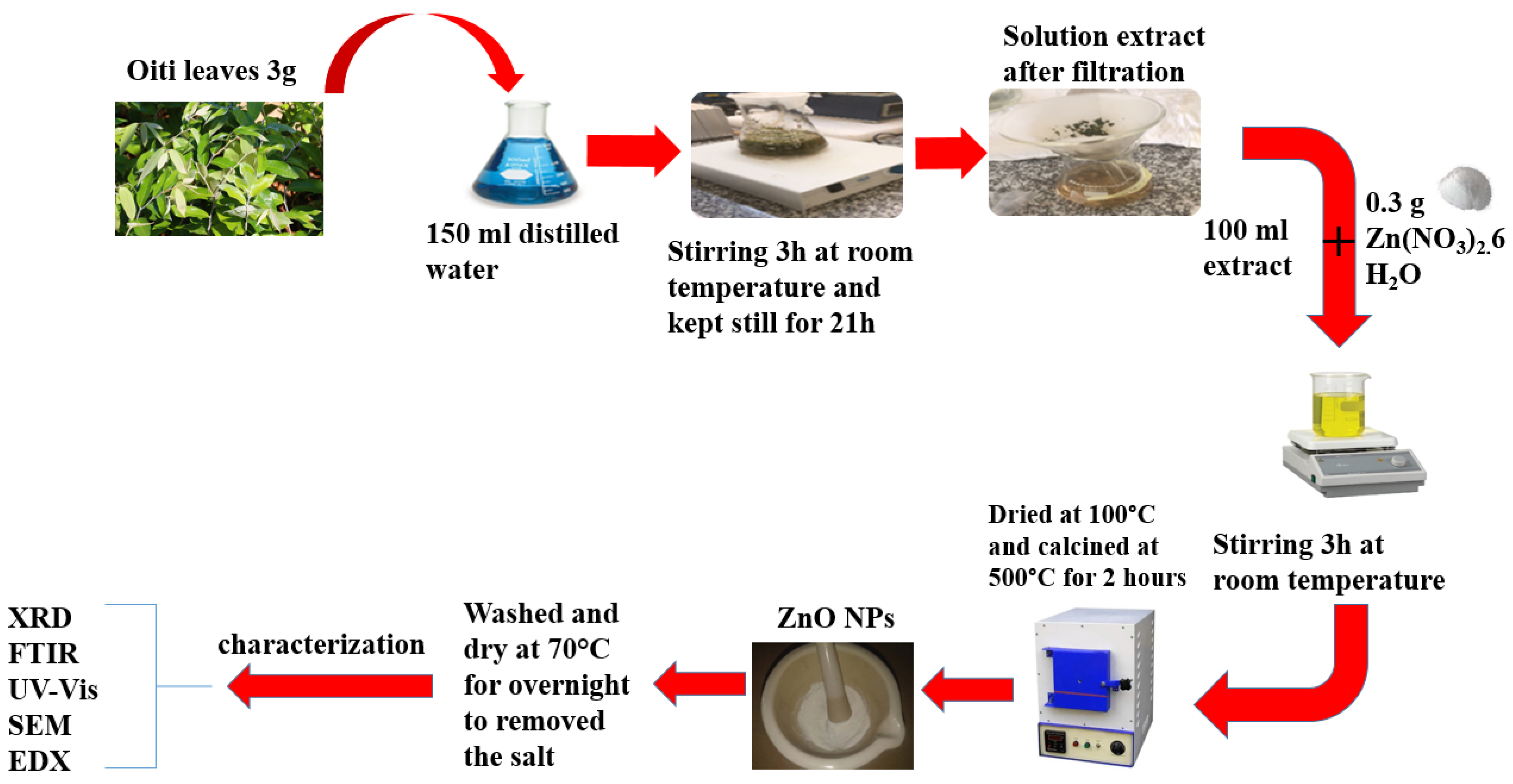

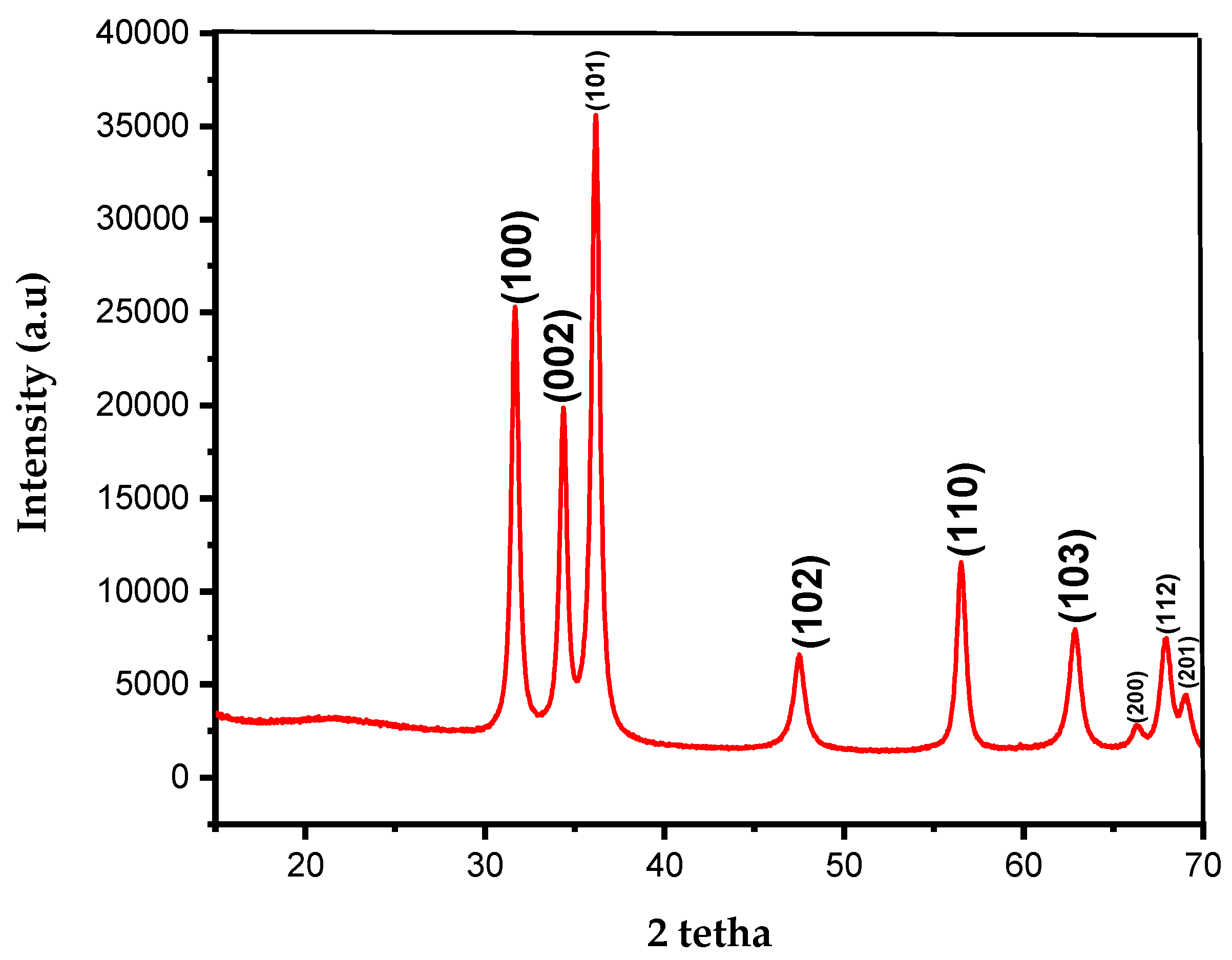
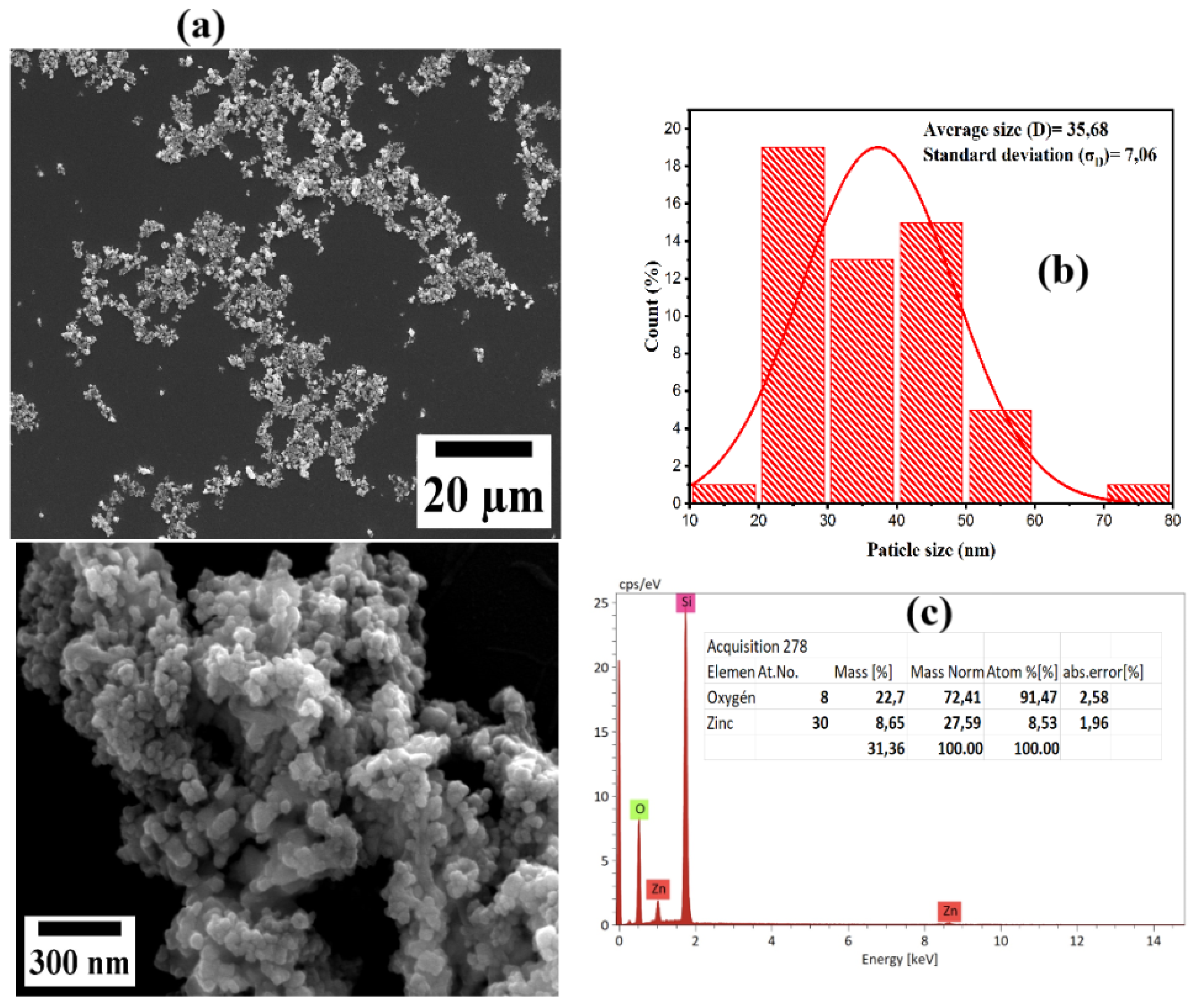
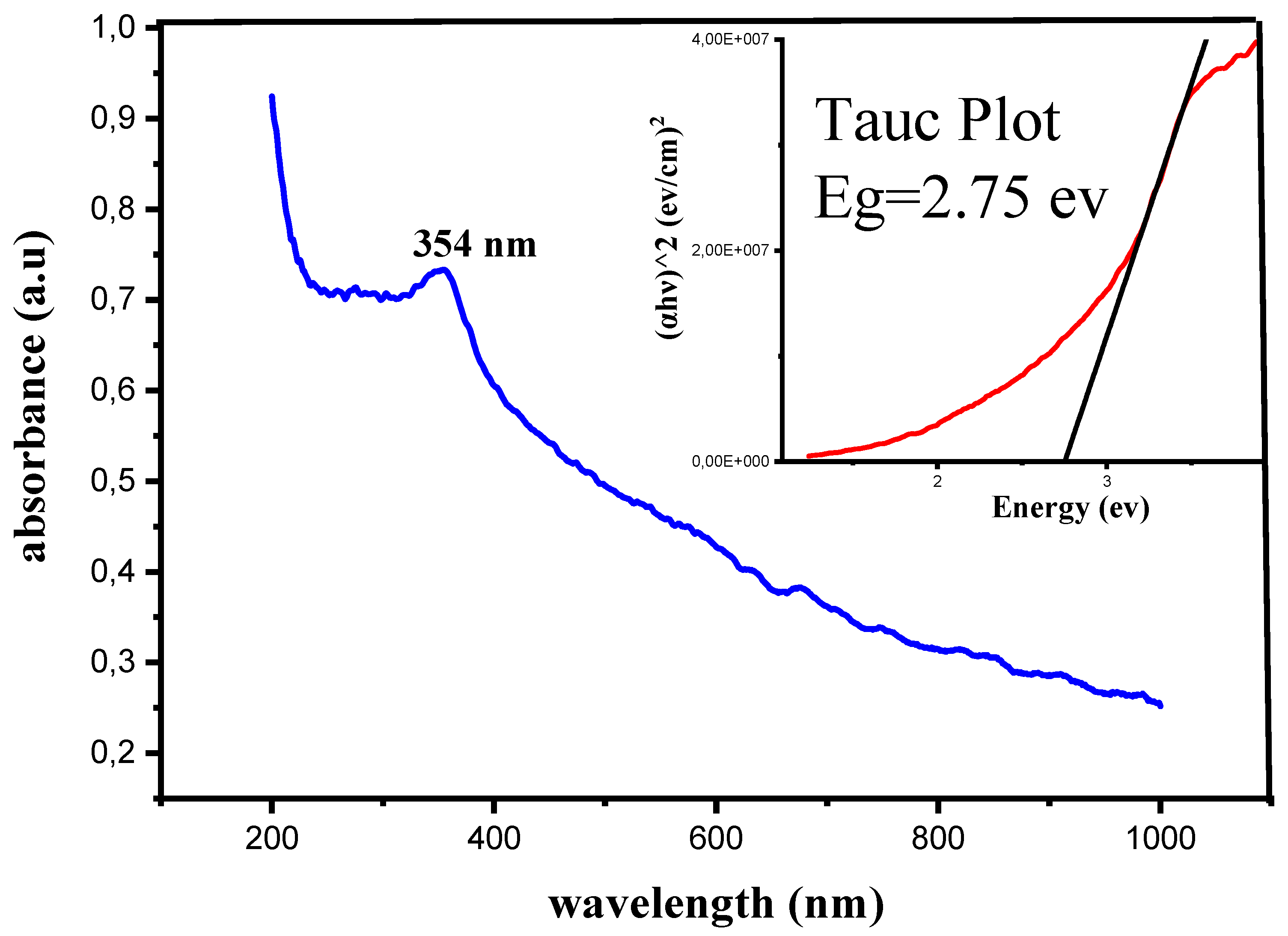
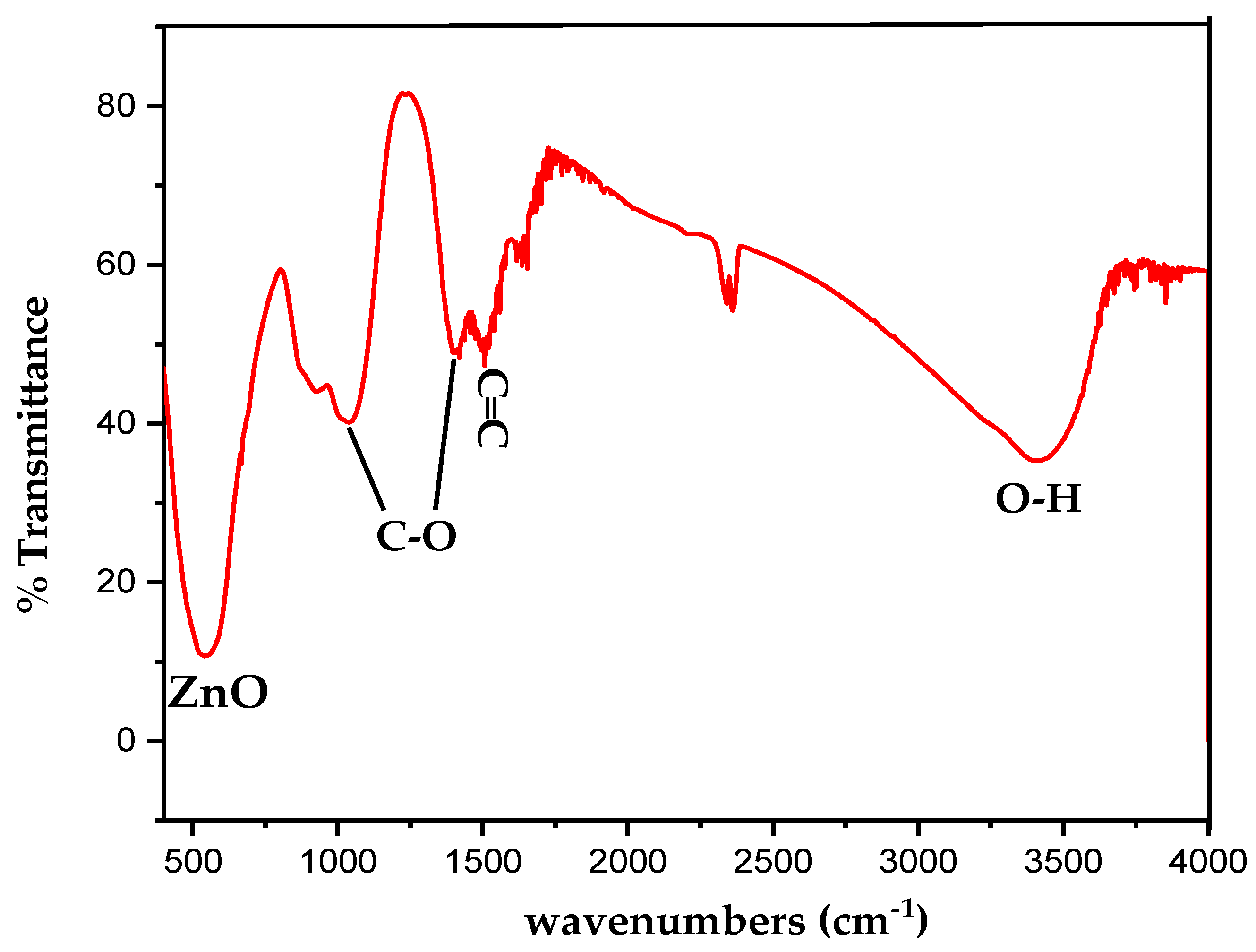
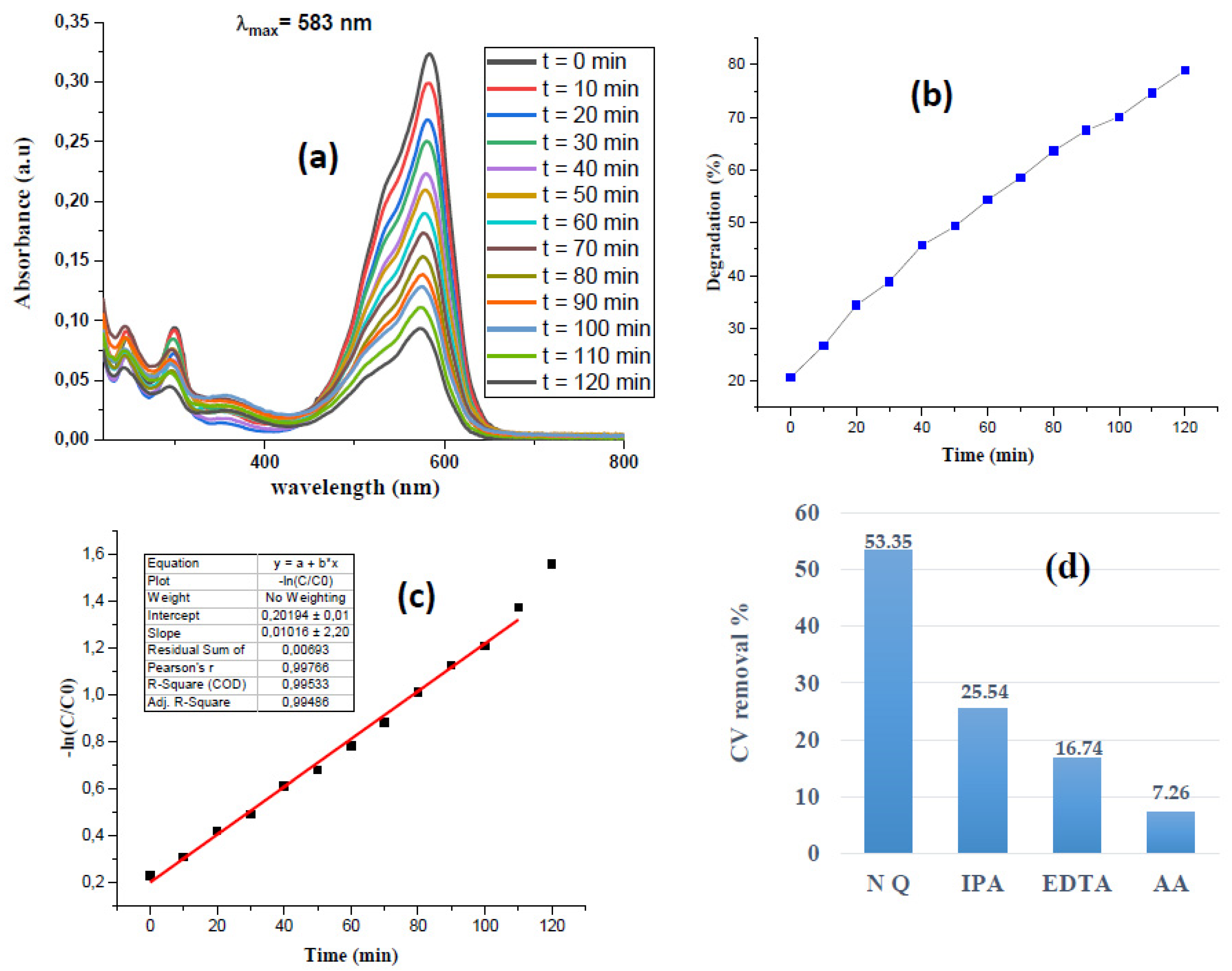
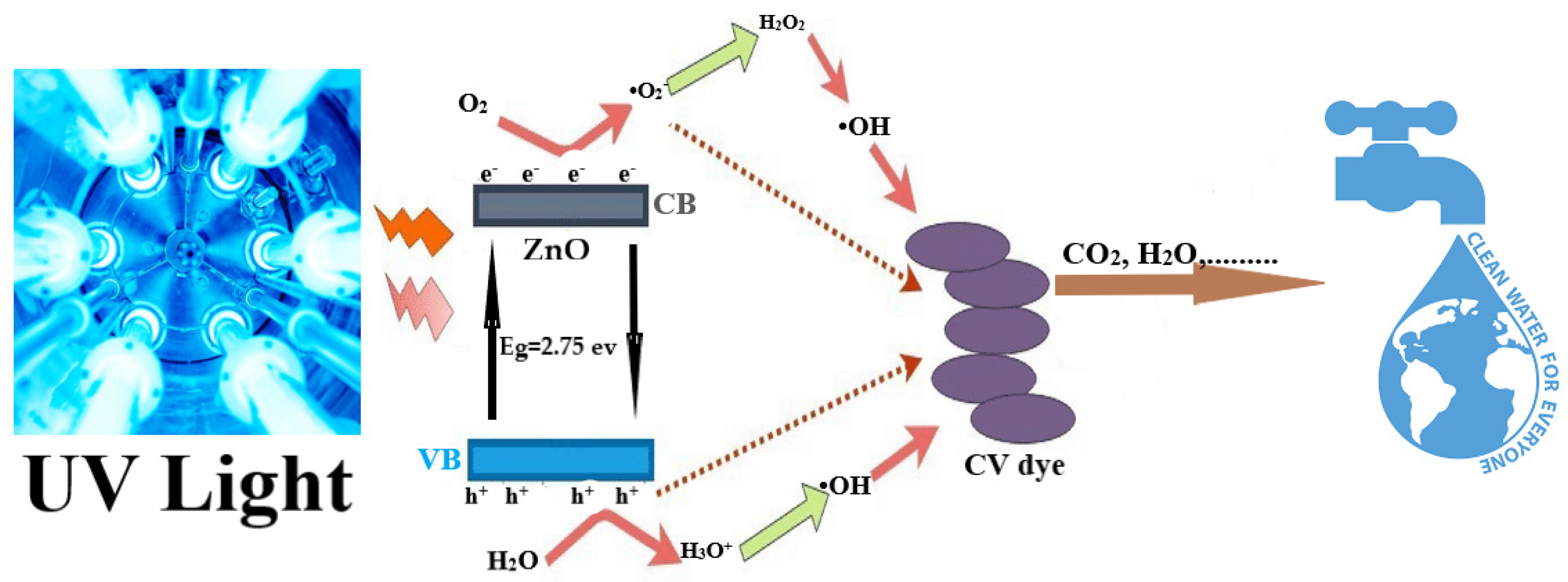
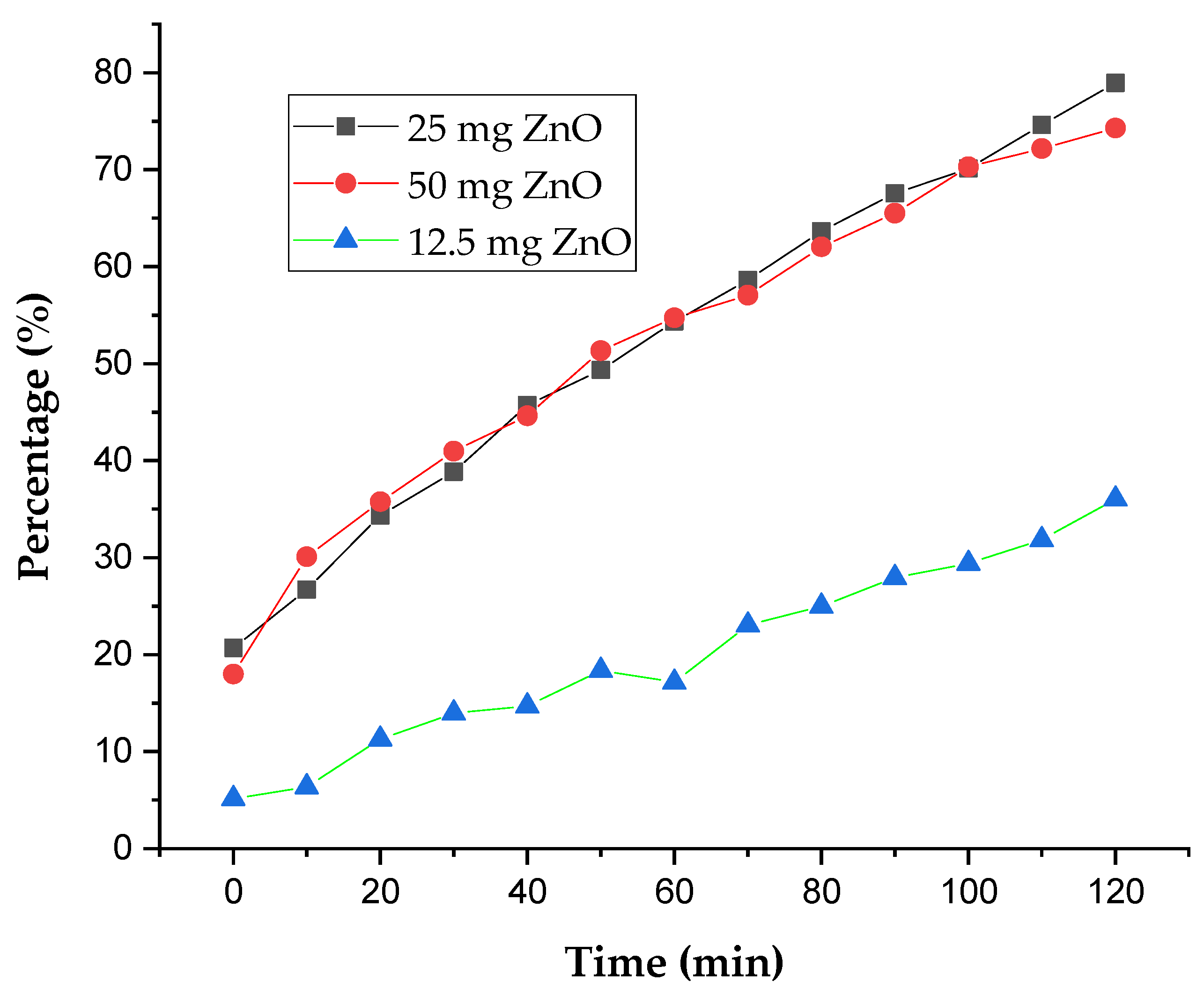
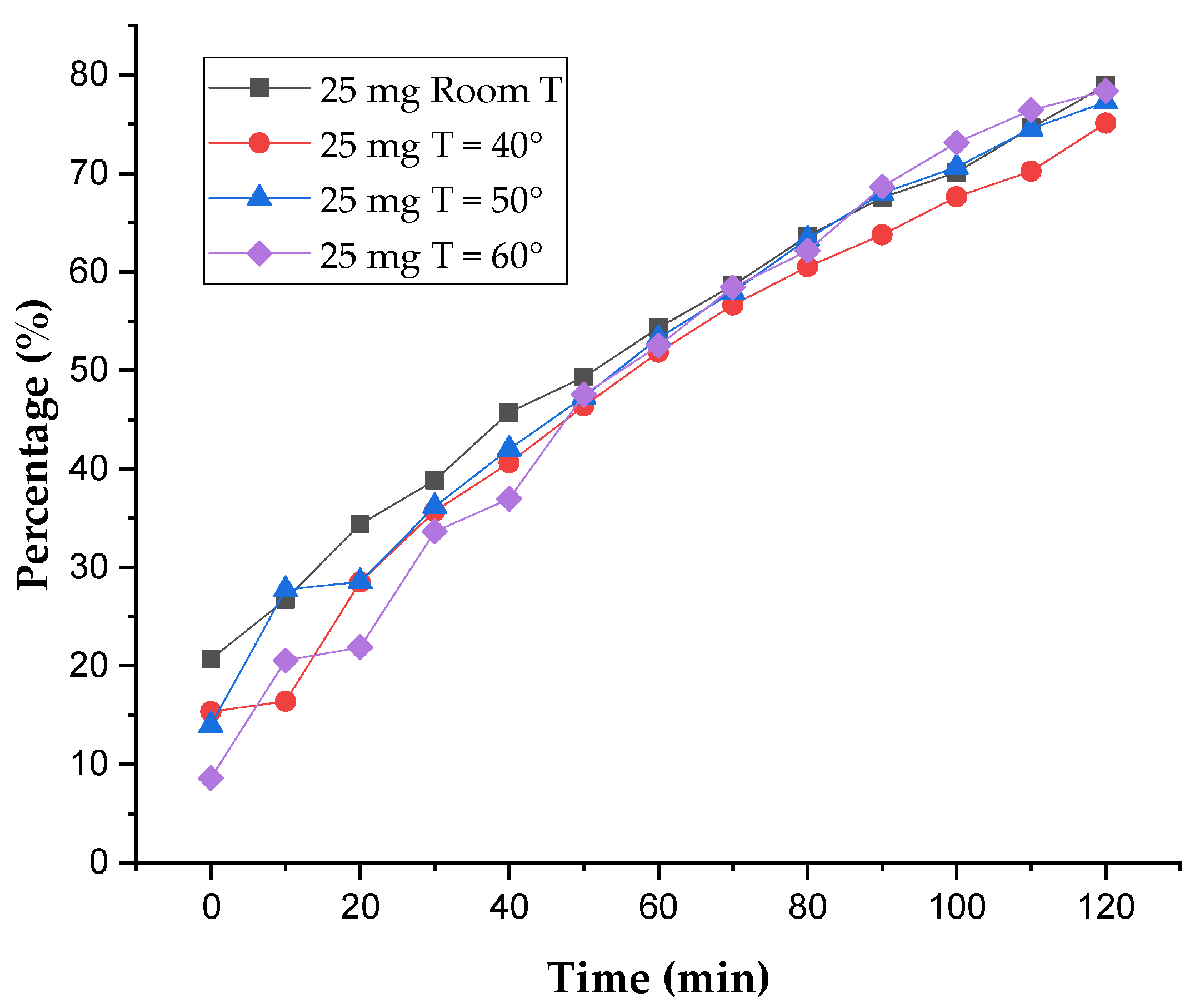
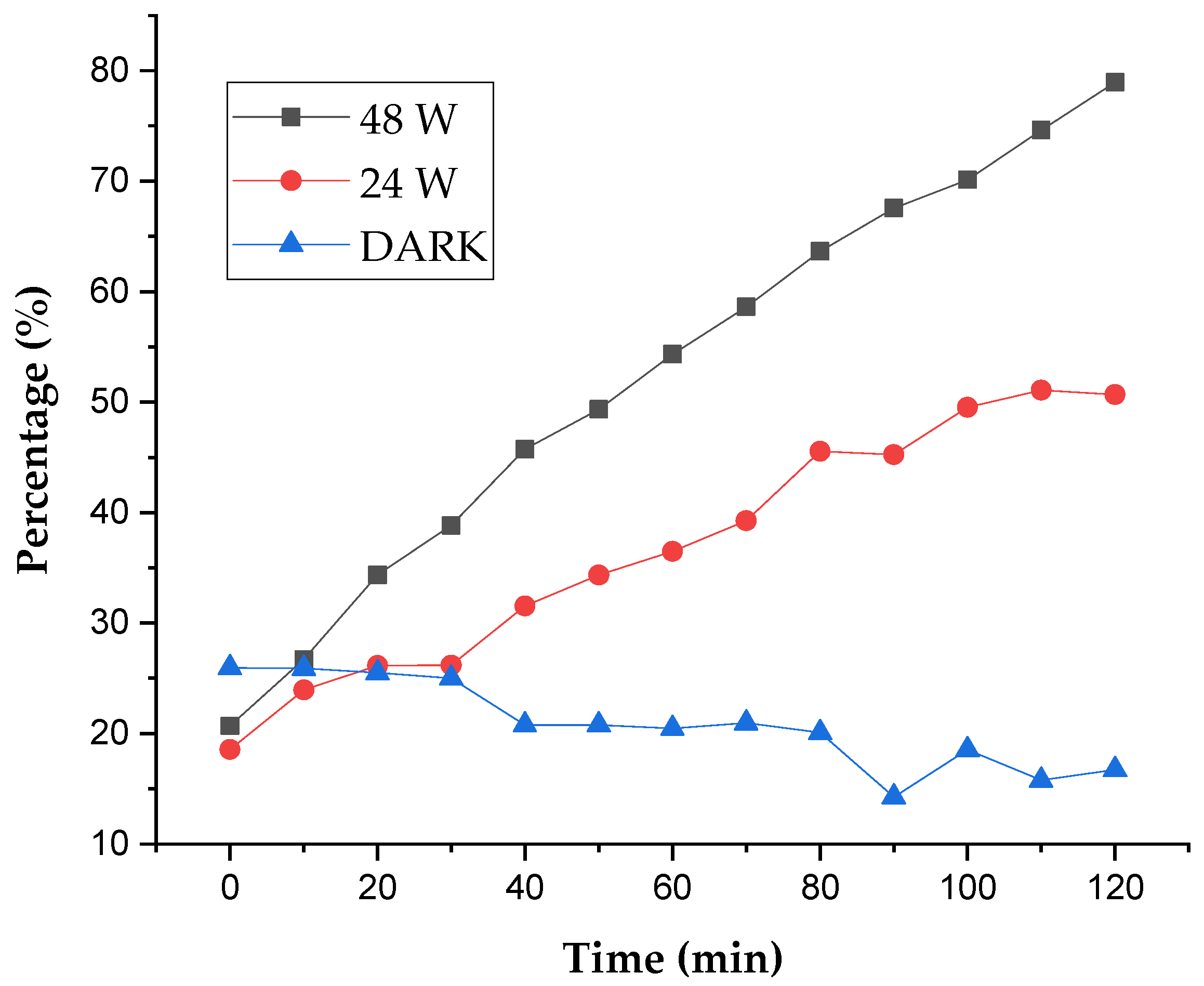


| 2 Theta Angles (Degree) | (hkl) | Intensities (a.u) | FWHM (Degree) | d(hkl), nm | Crystallite Size (nm) |
|---|---|---|---|---|---|
| 31.68 | (100) | 13,937.40 | 0.64358 | 0.28221086 | 11.88 |
| 34.39 | (002) | 10,991.96 | 0.72921 | 0.26056687 | 10.41 |
| 36.19 | (101) | 20,470.9 | 0.6853 | 0.24800907 | 11.02 |
| 47.51 | (102) | 1953.19 | 0.56568 | 0.19122373 | 12.85 |
| 56.53 | (110) | 4242.09 | 0.55264 | 0.16266489 | 12.66 |
| 62.88 | (103) | 2599.33 | 0.60442 | 0.14767869 | 11.21 |
| 66.32 | (200) | 2879.18 | 0.46 | 0.1408281 | 14.46 |
| 67.94 | (112) | 2353.67 | 0.6019 | 0.13785914 | 10.95 |
| 69.01 | (201) | 4099.63 | 0.4 | 0.13598053 | 16.37 |
| Mean crystallite size, nm | 12.4 | ||||
| dislocation density (δ), nm−2 | 0.0071 | ||||
| Micro-strain (ε) | 0.0081 | ||||
| Chemical Synthesis | ||||||
|---|---|---|---|---|---|---|
| Catalyst Load (mg) | Light Source | Removal Efficiency (%) | Initial Dye Concentration (ppm) | Rate Constant K (min−1) | Synthesis Method | Ref. |
| 100 | UV (300 W) | 96 (80 min) | 10 | not reported | Solution method | [42] |
| 80 | UV (125 W) | 82 (240 min) | 5 | 0.00739 | co-precipitation | [43] |
| 100 | UV (450 W) | 99 (150 min) | 10 | 0.01803 | co-precipitation | [44] |
| not reported | UV (100 W) | 86 (210 min) | 12.5 | 0.009 | Spray pyrolysis | [45] |
| Green Synthesis | ||||||
| Name of plant source | ||||||
| 50 | UV Not reported | 98 (90 min) | 10 | not reported | Leucocephala leaf extract | [46] |
| 20 | UV (500 W) | 86 (90 min) | 10 | 0.00624 | Delonix Elata Leaf extract | [47] |
| 25 | UV (48 W) | 79 (120 min) | 5 | 0.0102 | Oiti leaf extract | This work |
| Parameters | K (min−1) | T1/2 (min) | R2 |
|---|---|---|---|
| Catalyst loading (mg) | |||
| 25 | 0.0102 | 67.95 | 0.99486 |
| 50 | 0.00927 | 74.77 | 0.99474 |
| 12.5 | 0.00328 | 211.32 | 0.97806 |
| Temperature (degree) | |||
| Room | 0.0102 | 67.95 | 0.99486 |
| 40 | 0.00911 | 76.08 | 0.99039 |
| 50 | 0.01099 | 63.07 | 0.99327 |
| 60 | 0.0122 | 56.81 | 0.9725 |
| UV intensity (watt) | |||
| 36 | 0.00465 | 149.06 | 0.98055 |
| 72 | 0.0102 | 67.95 | 0.99486 |
| pH | |||
| 6.65 | 0.0036 | 192.54 | 0.97801 |
| 8.85 | 0.0102 | 67.95 | 0.99486 |
| Average Crystallite Size (nm) | Dislocation Density (δ) (nm−2) | Microstrain (ε) | Crystallinity (%) | |
|---|---|---|---|---|
| Before | 12.4 | 0.0071 | 0.0081 | 50.83 |
| After | 13.32 | 0.0056 | 0.0072 | 32.67 |
Disclaimer/Publisher’s Note: The statements, opinions and data contained in all publications are solely those of the individual author(s) and contributor(s) and not of MDPI and/or the editor(s). MDPI and/or the editor(s) disclaim responsibility for any injury to people or property resulting from any ideas, methods, instructions or products referred to in the content. |
© 2025 by the authors. Licensee MDPI, Basel, Switzerland. This article is an open access article distributed under the terms and conditions of the Creative Commons Attribution (CC BY) license (https://creativecommons.org/licenses/by/4.0/).
Share and Cite
Thiam, M.; Bernardo, A.d.J.; Pellegrini, V.d.O.A.; Possatto, J.F.; Dlamini, Z.W.; Mahule, T.S.; Ngom, B.D.; Mosepele, B.Q.; Thema, F.T.; Mamba, B.B.; et al. Green Synthesis of ZnO Nanoparticles Using Licania tomentosa Benth (Oiti) Leaf Extract: Characterization and Applications for the Photocatalytic Degradation of Crystal Violet Dye. Processes 2025, 13, 880. https://doi.org/10.3390/pr13030880
Thiam M, Bernardo AdJ, Pellegrini VdOA, Possatto JF, Dlamini ZW, Mahule TS, Ngom BD, Mosepele BQ, Thema FT, Mamba BB, et al. Green Synthesis of ZnO Nanoparticles Using Licania tomentosa Benth (Oiti) Leaf Extract: Characterization and Applications for the Photocatalytic Degradation of Crystal Violet Dye. Processes. 2025; 13(3):880. https://doi.org/10.3390/pr13030880
Chicago/Turabian StyleThiam, Moudo, Aparecido de Jesus Bernardo, Vanessa de Oliveira Arnoldi Pellegrini, João Fernando Possatto, Zolile Wiseman Dlamini, Tebogo Sfiso Mahule, Balla Diop Ngom, Belda Q. Mosepele, Force Tefo Thema, Bhekie B. Mamba, and et al. 2025. "Green Synthesis of ZnO Nanoparticles Using Licania tomentosa Benth (Oiti) Leaf Extract: Characterization and Applications for the Photocatalytic Degradation of Crystal Violet Dye" Processes 13, no. 3: 880. https://doi.org/10.3390/pr13030880
APA StyleThiam, M., Bernardo, A. d. J., Pellegrini, V. d. O. A., Possatto, J. F., Dlamini, Z. W., Mahule, T. S., Ngom, B. D., Mosepele, B. Q., Thema, F. T., Mamba, B. B., Vallabhapurapu, S., Vallabhapurapu, V. S., & Polikarpov, I. (2025). Green Synthesis of ZnO Nanoparticles Using Licania tomentosa Benth (Oiti) Leaf Extract: Characterization and Applications for the Photocatalytic Degradation of Crystal Violet Dye. Processes, 13(3), 880. https://doi.org/10.3390/pr13030880










